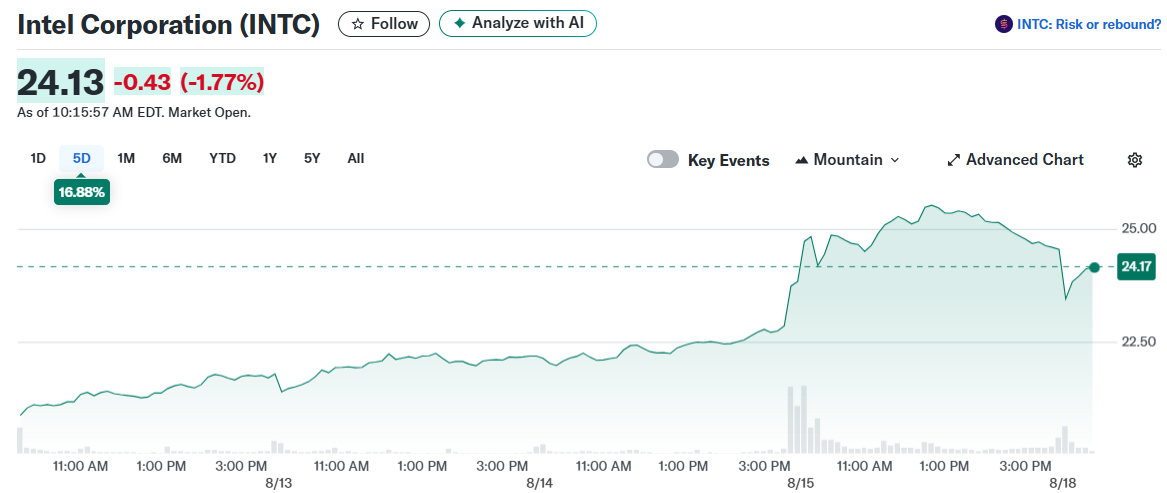TLDR
- Intel shares climbed 24.1% this week following reports of potential government investment discussions
- CEO Lip-Bu Tan’s White House meeting with President Trump appears to have resolved earlier tensions over Chinese business connections
- Federal stake could revive Intel’s stalled Ohio manufacturing facility, originally designed as a massive chip production hub
- Stock closed at $23.86 on August 14 after gaining 7.4%, pushing market value to around $104.4 billion
- Investment talks remain preliminary with no confirmed deal structure or timeline announced
Intel found itself at the center of Washington’s attention this week as shares rocketed higher on government investment speculation. The semiconductor company’s stock posted impressive gains following a pivotal White House meeting.

CEO Lip-Bu Tan’s sit-down with President Trump marked a complete reversal from recent tensions. Just last week, Trump had publicly demanded Tan’s resignation over security worries related to his Chinese business relationships.
The face-to-face meeting appears to have changed everything. Trump emerged describing Tan as having an “amazing story,” signaling a dramatic shift in their relationship.
Reports soon followed that the administration is exploring a direct investment in the struggling chipmaker. Bloomberg sources suggest these talks stem directly from the Trump-Tan meeting.
The proposed government stake lacks specific details about size or structure. Officials familiar with the discussions emphasize that conversations remain in early stages.
Manufacturing Revival Plans
Intel’s troubled Ohio project could benefit most from federal backing. The company had envisioned creating the world’s largest semiconductor manufacturing complex in the state.
Those plans hit multiple roadblocks and delays over recent months. Intel ultimately shelved its original timeline for the massive facility.
Government investment might provide the financial foundation needed to restart construction. The project represents a cornerstone of domestic chip production efforts.
Federal funding could help Intel compete with overseas manufacturers who have received substantial government support. The Ohio facility would create thousands of manufacturing jobs in a critical technology sector.
Market Enthusiasm
Wall Street responded immediately to the investment rumors. Intel stock jumped as high as 8.9% during regular trading on August 14.
Shares settled at $23.86 by market close, representing a solid 7.4% daily gain. After-hours trading added another 4% to the rally.
The weekly performance put Intel among the top gainers in the semiconductor space. Most chip stocks posted modest gains while Intel dominated headlines.
Investors seem optimistic that government backing could stabilize Intel’s financial position. The company has been cutting costs and reducing workforce to manage cash flow pressures.
Intel’s domestic manufacturing footprint gives it unique strategic value compared to rivals. Companies like Nvidia and AMD rely heavily on overseas production facilities.
This manufacturing presence aligns with current political priorities around technology independence. Both the current and previous administrations have emphasized domestic semiconductor capacity.
Official Responses
The White House downplayed speculation about specific deal terms. Spokesman Kush Desai urged treating unannounced agreements as hypothetical.
Intel maintained its standard position of not commenting on market rumors. Company representatives emphasized their commitment to working with the administration on technology leadership goals.
The measured responses suggest negotiations could continue for weeks or months. Complex government investments typically require extensive legal and regulatory review.
Recent precedents show the Trump administration’s willingness to take direct stakes in strategic companies. The Defense Department announced a $400 million investment in rare-earth producer MP Materials Corp.
That deal made the Pentagon the largest shareholder in the mining company. Similar arrangements could emerge for other companies deemed critical to national security.
Intel’s strategic importance extends beyond current financial performance. The company maintains extensive U.S. research and development operations alongside its manufacturing capabilities.
The discussions indicate Tan will likely keep his CEO position despite earlier controversy. A successful investment agreement would represent a major win for his leadership team.
Federal support arrives as Intel implements aggressive cost-reduction measures across multiple divisions. The company has announced significant workforce cuts and facility consolidations.


